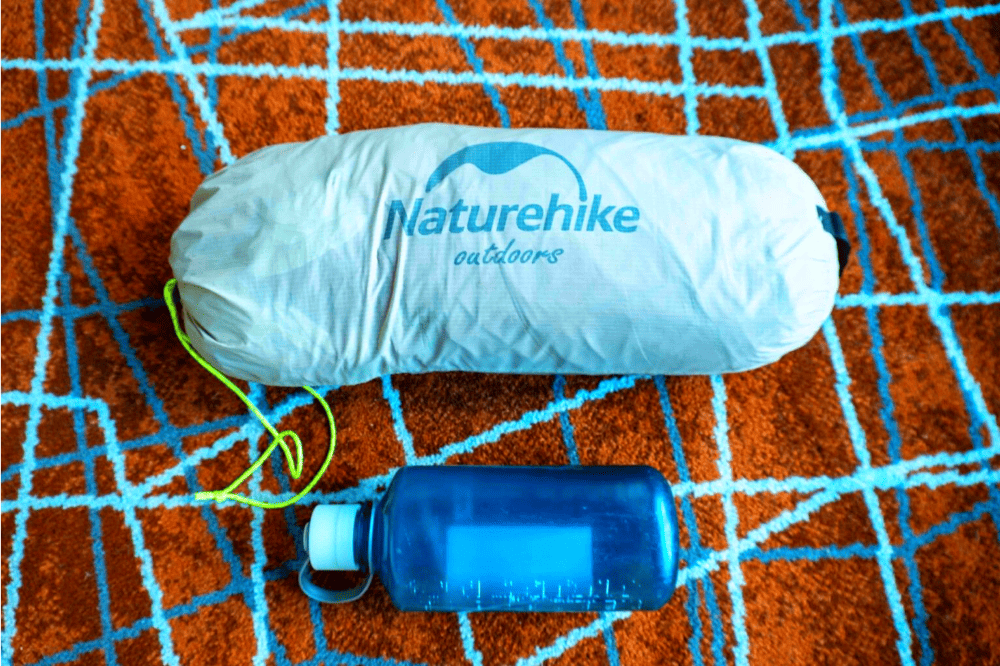A compression sack (or stuff sack) works wonders for reducing the space taken up by a sleeping bag.
If you’re a backpacker, you’ll hate how much room your tent takes up in your bag. So can you put a tent in a compression sack?
Can You Put a Tent in a Compression Sack?
In short, Yes. A tent is one of those supplies that takes up lots of space. Therefore, putting it in a compression sack will save lots of space. However, don’t leave them in there for too long because compression sacks aren’t meant for storing them for the long term.
The tent poles must be placed separately and poles that are pre-attached can’t go in a stuff sack. Leaving a tent inside a compression sack too long creates the potential to damage the tent’s fabric.
Related: Looking for a quality small tent? Check out our review of the best 2 person tent.
How a Compression Sack Differs from a Stuff Sack
A compression sack is similar to a stuff sack. It is utilized to make the most of the small space available in a backpack. The most common use for a compression sack is storing sleeping bags and other camping equipment. To permit the person to tie down the compression sack, it normally comes with three to five straps or lines.
Compression Sack vs Stuff Sack
The compression sack sucks all the air out of the sack to make more room for supplies. The stuff sack allows you to fill supplies in it that the compression sack doesn’t hold. Therefore, the use of a compression sack in combination with a stuff sack ensures sufficient room for everything.
Drawstring or Roll Top?
If you need to store your gear in an enclosure that is airtight, then roll tops are the way to go. These sacks are bug-proof and waterproof and will ensure all your belongings are kept safe. In addition, an airtight sack like this allows it to be used somewhat like a compression bag–only no extra straps.
If you are looking for easier, faster, and lightweight ways to pack your gear, then drawstrings are best. A drawstring opening allows easy access to all your camping and backpacking stuff, which is why it is often the sack of choice.
Some Reasons You Might Want to Put a Tent in a Compression Sack
You might have any number of reasons for wanting to put your tent in a compression sack. Listed below are just a few:
- Trying to make room for other camping equipment, since a tent takes up a lot of space.
- When it is not convenient to use a regular tent bag.
- You want to keep other camping items compartmentalized in the tent.
Other Items to Store in a Compression Sack
Tents should not be stored in a compression sack for more than two or three days, particularly in hot weather. The reason is that a tent can become irreparably damaged if placed inside a compression sack for too long. Instead of storing the tent in a compression sack, there are other camping items you can compress to save space. These items include (but are not limited to):
- Storing the sleeping bags in a compression sack is an excellent idea. Not only does it save room, but when sleeping bags are rolled uptight, they trap less air.
- Clothing can create a lot of bulkiness for your luggage. Compress your outfits into a compression sack and save space for storing other necessities.
- Cleaning clothes and towels are other items that take up a lot of room. These types of items are best packed away tightly in a compression sack to save space.
How to Know What Size Compression Sack to Use
You will need to ensure you are using the right size compression sack for the storage of a tent. This size is determined by how thick the fabric is you want to compress. In addition, you need to check the volume of compression–this is how much space the compressed sack will take up. These measurements are imperative, so you know how much internal storage your compression sack has available.
What Type of Compression Sack to Use?
Once you have determined what size of compression sack you need, you need to know the type. This is something that best fits your preference type. As well as the occasions or activities you will be using it for. You also need to take into consideration the terrain and whether you will be near water. Some of the criteria that may be taken into consideration regarding the type of compression sack include:
- Is it waterproof?
- How much does it weigh?
- How durable is it?
Compression sacks also come in two styles–drawstring or roll-top. Again, the one you choose is purely based on what you prefer.
However, if you want a sack that averts debris, moisture, and sand, the roll-top stuff sacks are best.
